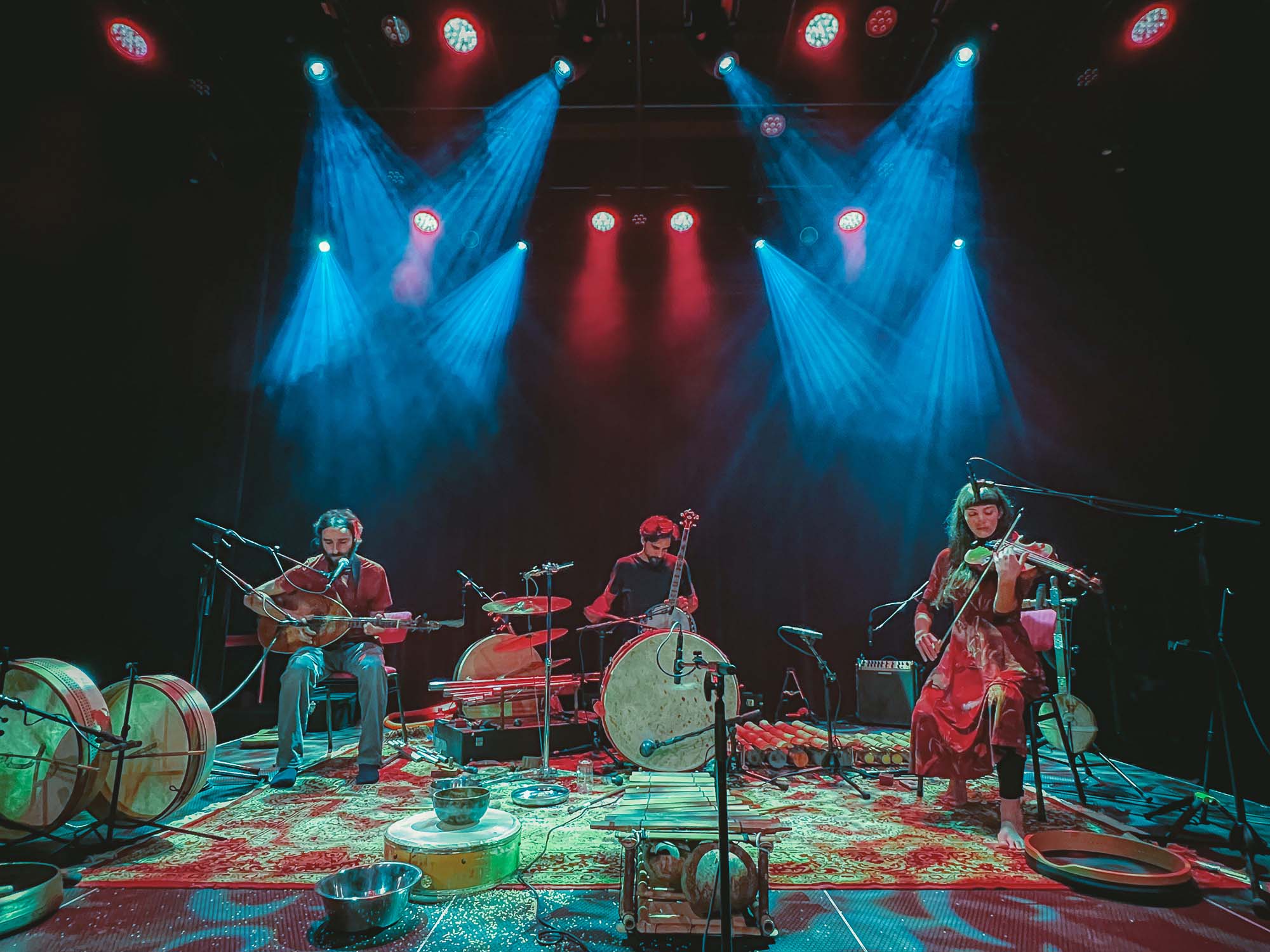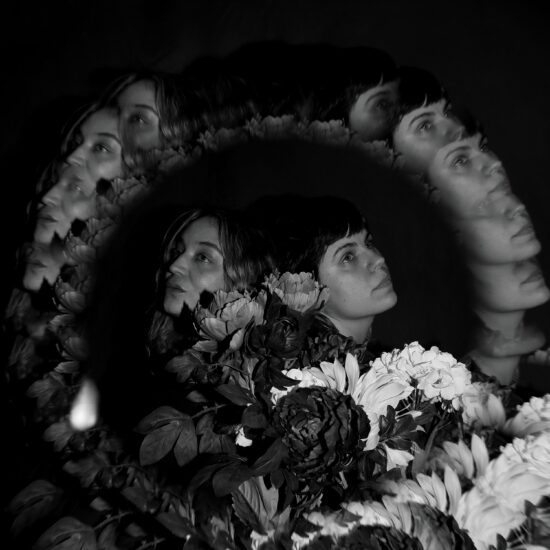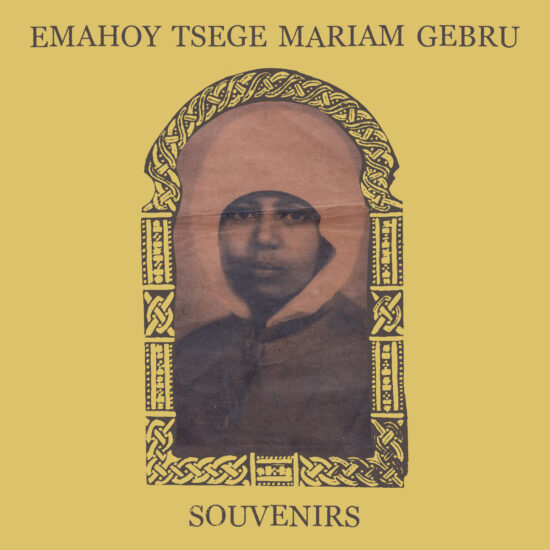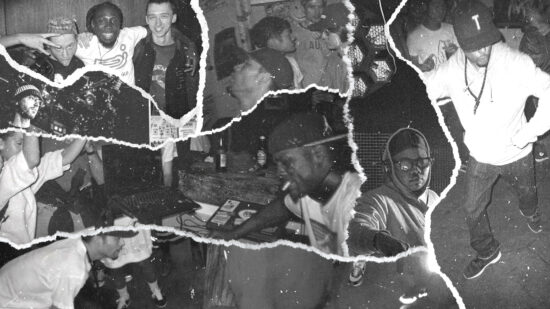In a fifteen minutes I can be in Algeria, São Tomé, Bogotá, Hokkaido or Ljubljana. This is the essence of the festival: there is a strength in diversity that is as great as nowhere else in Europe.
Now I know clearly what ‘imaginary folk’ means. I speak with Širom in May, now I see them live. To play it, you just have to imagine what can be played on and do it.
I stand a few meters away from Samo Kutin in Cloud 9, the highest-located concert hall in Tivoli Vredenburg in Utrecht. Rather than playing, Kutin is ‘creating sound’ using anything that came into his hands: a hurdy-gurdy, a balafon, some old pots, sticky tape, a pinwheel, confetti, and drums. “Our music comes from a rural area, and in this building, we feel like we’re in a spaceship,” he says in the middle of the concert. Širom plays three songs from their album The Liquified Throne of Simplicity, which lasted several dozen minutes in total. Each song is a separate microcosm, created by Iztok Koren, who plays mantric rhythms on the drums; Ana Karvaja, who sings and explores the violin, marimba, and pipes; and Samo Kutin, who plays the hurdy-gurdy by hooking the strings, hat created the lashing effect, which guitarists are often known for.
The trance-like and meditative nature of their music is other-worldly. Repetitions climax only to be broken by another instrument – a counterpoint to the drama. What is most remarkable in Širom’s music is its lingering and meditative character. They are mystics by nature. Throughout the pandemic, they met to preserve the ritual of playing, and now they’re taking it to the stage. There is rapture, a whole palette of colors, and new imaginary worlds. The Slovenian trio fired it up and filled the entire space of the hall with sound.
Another day: the minimalist microtonal Sufi music played by The Master Musicians of Jajouka seems endless. The group starts by playing on the ghaita, a double reed horn with a set of holes in the pipes, and then adding a different kinds of percussion and other instruments. One of the most interesting – in terms of sound and the way of playing was kamanja – a violin played upright on the knee. Further, into the performance, the musicians swap the instruments. The drums are not meant to buck the rhythm but rather to add another texture of sound. The songs are elongated and there are many ecstatic solos such as the one in ‘Habibi N’sitni’.

OKI 
Irena & Vojtěch Havlovi
Perhaps because of the way they were sitting, it was all kind of static. It was completely different from Africa Negra’s performance that took place the other day: it was full of endless, cheeky rhythm – a hedonistic siesta stretched out over time. The pulsating rhythms from São Tomé, catchy solos, and polyphonically intertwining guitars spark joy and it’s impossible not to dance. General João Seria high-fiving people in the front rows is one of the best moments of this year’s festival. The performers create a relationship with their audience through movement and gestures. What matters the most is the story, but the dance is just as vital.
Noori & His Dorpha Band, who perform in Janskerk recently, know that too. They play warm blues with saxophone swirls and wry solos, which add a color to the guitars in the back. The Master Musicians of Jajouka play traditional music, Africa Negra creates new traditions, and Noori & His Dorpha Band dialogue with Sudanese music from decades ago. They combine Port Sudan’s aesthetic with the guitar ethos of the Western world. Here, at Le Guess Who?, it’s easy to get confused by all of the different music styles and movements. Noori (his full name is Noureddine Atta Al-Mawla Jabar), who, at the forefront, plays a self-created tambo-guitar, is a great example of a musician who mixes very different, seemingly unrelated musical elements. His handcrafted instrument is the result of combining the capabilities of a tambour and an electric guitar that he once found. From this emerges a new quality and Beja music remains alive.
When I meet my friends at Le Guess Who?, I notice that practically every one of them seems to have attended a different event than the other. Therein lies the essence of this festival. Nowhere else in Europe is there such an enormous power in diversity as there is here.

Master Musicians of Jajouka
A few minutes before OKI starts the performance, I see the band’s leader, Oki Kano, pacing around the stage and finishing a soundcheck, dressed in jeans and a T-shirt. As the concert begins, he came out in his traditional outfit. Together with three other musicians, he gains seriousness, and they create a ritual, aiming for a performative quality of a traditional Japanese song. No matter what element they use: jazz walking, dub, prog-rock jams, or mouth harmonica solos. The group arranges all the different sounds without being showy. From that performance, I will remember a remarkable story, engaging music, and the dance ritual.
In the cramped and hot EKKO venue, just above one of Utrecht’s canals, Romperayo plays cumbia with a rhythmic breakbeat, not giving the audience a moment to rest. The drummer, Pedro Ojeda, has not stopped playing even for a second during the performance. Accordionist Ivan Medellín turns up the atmosphere in the foreground, aided by the Moog synthesizer of Juan Manuel Toro. There is irresistible energy, enthusiasm, and extraordinary creativity in their modern approach to Colombian tradition.
From South America, I’m moving to Algeria to listen to raï music, which is characterized by the lyrics dedicated to social issues. It is performed in Pandora Hall by Cheikha Rabia, one of the last living artists working in this genre. The accompaniments are synthetic beats and melancholic, fleeting synth strands, as well as flute and percussion. At one point, Eesra Werda takes to the stage and tell the audience about the history of the band, but what is most remarkable, she dances. Everything hovered in perfect symbiosis as if we were marching unhurriedly through the streets of Oran. “Please dance,” she calls out to the people.

Noori & His Dorpha Band 
Alison Cotton
If you’re not feeling like dancing, then what? Come and see Alison Cotton’s mystical concert. I watch it from the second floor of the auditorium in Hertz Hall. Looking over the railing, I felt like I was watching a time loop or some sort of mystical source of ancient music. The cellist sounds like a soothsayer – she electrifies the instrument, using various effects to create an atmosphere of mystery.
Irena and Vojtěch Havlovi give a theatrical performance in Janskerk – they play the viola da gamba but also try to find different sounds amidst the silence: striking strings with a bow, scratching and tapping them. Irena’s gentle and quiet voice brings lyricism to it all. At one point, she is sitting down behind the piano, and together with Vojtěch, they spin an impressionistic improvisation. Vojtěch, privately Irena’s husband, approaches her and embraces her while she is still playing the piano. It is an emotional, special moment when they play a variation of ‘Absence of the Loved One’ together. But it is not over yet – at one point, Vojtěch unexpectedly disappears, and a moment later, I hear the powerful sound of the organ on which they play the extraordinary ‘Intervals of Waiting’. An incredible, monumental ending.
It also happens to be heavier than Havlovi or Cotton performances. The concert of Mabe Fratti, whose music is relatively subtle and subdued on record, sounds powerful at Jacobikerk. Her cello, plugged into the amplifiers, explodes into the metal aesthetic at times. The effect is amplified even more by a second guitarist and a drummer who plays with her. This is the first concert I wear earplugs at. The compositions from Se Ve Desde Aquí gain momentum live, and Frattis’s voice carries around the church and combined with the theatrical lighting of the space, makes a strong impression.

Turner Williams Jr.
EXEK, whom I see on Sunday at De Helling, several minutes drive from the center of Utrecht, sounds different than on the album too. While the music on Advertise Here sounds like art-rock and is a bit withdrawn, colored by a saxophone or sitar lines, the instrumental reduction at a live performance emphasized its punk ethos. Jai K Morris-Smith’s guitar and Andrew Brocchi’s plucky Moog sounds brilliantly with Albert Wolski’s cool and powerful vocals.
The other side of the post-guitar tradition is the Turner Williams Jr.’s concert that takes place at LE:EN a few meters away. He plays on the “shahai baaja” – an instrument that resembles a steel guitar or a sitar and is made of a board with effects and strings modulated by typewriter buttons, sometimes veering towards drone music. He starts calmly, then plays in an increasingly jagged way. The composition thickens and the sound texture becomes rough, like rootsy and primitive blues. It is a great solo performance, rooted in the blues-folk tradition, based on which an original language emerges.
Last to play in this quarter are Kuunatic, a Japanese trio whose prog-rock forms hint at metal, but also draw from oriental sounds backed by heavy basslines. They perform with painted patterns on their faces and sound expressive. Dressed in white, they look like shamans which enhanced the sound of Kagura’s flute, a shamisen-like sound served up on the keyboards, and the all-group singing. As far as dramaturgy is concerned, this is one of the most interesting concerts of the festival.
From De Helling, I return to the Tivoli to see Horse Lords. The band talked to me earlier this year about their preparations for the tour and the new album, Comradely Objects, which they have played live. They start with minimalist repetitions, which led them to algorithmic computer music. The quartet’s original approach to tonality and polyrhythm kind of reminds me of what I have seen earlier at the festival: the repetitions and reductions of Africa Negra, the bluesy jamming of Noori, or the polyphonic intonations of The Master Musicians of Jajouka.
Gardner and Eilbacher of Horse Lords mentioned in the interview that the purpose of their live performance was to ‘rebuild the relationship with the audience after it had been interrupted by the pandemic. When they play ‘Mess Mend’ in Pandora Hall, the electronic parts compress, and the whole thing builds to a crescendo. It sounds like I’m listening to the sound of a space shuttle being launched. I recall Samo Kutin’s words from the Širom concert and imagine a ‘the spaceship has taken off’ announcement in the background. The proper announcement for that moment would probably be ‘a relationship was rebuilt’. After all, in front of the stage, it looks the same as it did during São Tomé’s group or Cheikha Rabia and Eesra Werda performances: people are dancing, and everyone is enjoying themselves. The relationship between the audience and the performers is closer and more tender than ever.

EXEK




